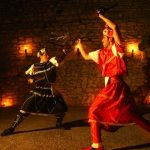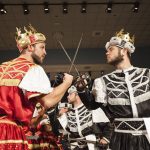Moreška remains one of the staples of tradition on Korčula, but what are its origins?
It was some time ago when I watched the highly acclaimed TV show “Oz and James Drink to Britain” (the third season of the “Oz and James’s Big Wine Adventure”, focusing on Great Britain and obviously not on wine, rather other alcoholic beverages popular there). In episode 7 of the series, I actually stopped in my tracks when they went to Cornwall, at the South-West of England, after having had a lot of cider and G&Ts and some beer, and Oz surprised James with a performance of Morris dance.
That obviously got me thinking, what could possibly be the link between Korčula, where a very famous dance is called moreška, and England, where a not at all similar dance (I mean, except for the fact that it has men wielding sword-shaped objects) is still performed and called “morris dance”? Could there be a link?
Well, of course there is.
As we already described in our previous articles about moreška, its roots go back to the 12th century Spain, where a similar mock-battle dance was performed to celebrate the victory of Christians agains Moors (La Morisca de Gerri de la Sal was first mentioned in 12th century) during the so-called Reconquista. Since then, the tradition of such mock-battle dances with similar motive (and the basic story is very, very simple: the army of the bad guys steals the girl of the good-guy’s general; they fight over her, good guys win the battle and win the girl back) has spread throughout Mediterranean Europe, but also to England, Germany and as far as Guatemala!
Of course that the variants have changed accross the world and during centuries since it’s been around, so there probably aren’t that many similarities between the performaces of moreška on Korčula and any other variants of the ancient Spanish mock-battle dance. And there has been a lot of time for Croatian, Korčulan variant of moreška to develop some specificities: the first mention of the dance by the similar name on our coast was in 13th century in Trogir, while on Korčula it was first danced in the late 16th or early 17th century.
Other Croatian coast towns also used to have their tradition of similar dances, and we know it was performed in Dubrovnik, Zadar, Hvar and Split, but only in Korčula has it survived as an important part of their tradition, and memory of the past. Interestingly enough, Korčula was never in any conflict with the Moors (of course), and the three known historical versions of the plot of moreška have three different variations of the identity of the sides in the conflict, with the final one (still performed today) confusingly identifying the White king, good guy in the story, as the Turkish military commander Osman – effectively making it a battle between the Turkish army and the Moor army, thus removing it from its “Reconquista” roots.










